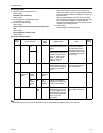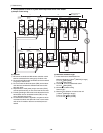
- 36 -
[ II Restrictions ]
GBHWE09080
(4) Wiring method
1) Indoor-heat source transmission line
Daisy-chain terminals M1 and M2 on the terminal block
for indoor-heat source transmission line (TB3) on the
heat source units (OC, OS1, OS2) (Note 1), terminals M1
and M2 on the terminal block for indoor-heat source
transmission line (TB5) on each indoor unit (IC), and the
S terminal on the system controller. (Non-polarized two-
wire)
Only use shielded cables.
The heat source units in the same refrigerant circuit are
automatically designated as OC, OS1, and OS2 in the
order of capacity from large to small (if two or more units
have the same capacity, in the order of address from
small to large).
Shielded cable connection
Daisy-chain the ground terminal ( ) on the heat source
units (OC, OS1, OS2), the S terminal on the terminal
block (TB5) on the indoor unit (IC), and the S terminal on
the system controller with the shield wire of the shielded
cable.
2) Transmission line for centralized control
Daisy-chain terminals M1 and M2 on the terminal block
for transmission line for centralized control (TB7) on the
heat source units (OC) in different refrigerant circuits and
on the OC, OS1, and OS2 in the same refrigerant circuit.
If a power supply unit is not connected to the transmis-
sion line for centralized control, replace the power jump-
er connector on the control board from CN41 to CN40 on
only one of the heat source units.
Set the central control switch (SW2-1) on the control
board of all heat source units to "ON."
Only use shielded cables.
Shielded cable connection
Daisy-chain the S terminal on the terminal block (TB7) on
the heat source units (OC, OS1, OS2) with the shield
wire of the shielded cable. Short-circuit the earth terminal
( ) and the S terminal on the terminal block (TB7) on
the heat source unit whose power jumper connector is
mated with CN40.
3) MA remote controller wiring
Same as [5] 1.
When 2 remote controllers are connected to the sys-
tem
Same as [5] 1.
Group operation of indoor units
Same as [5] 1.
4) LOSSNAY connection
Connect terminals M1 and M2 on the terminal block
(TB5) on the indoor units (IC) to the appropriate termi-
nals on the terminal block for indoor-heat source trans-
mission line (TB5) on LOSSNAY (LC). (Non-polarized
two-wire)
Indoor units must be interlocked with the LOSSNAY unit
using the system controller. (Refer to the operation man-
ual for the system controller for the setting method.) In-
terlock setting from the remote controller is required if the
ON/OFF remote controller alone is connected.
5) Switch setting
Address setting is required as follows.
(5) Address setting method
The heat source units in the same refrigerant circuit are automatically designated as OC, OS1, and OS2.
Proce-
dures
Unit or controller
Address set-
ting range
Setting method Notes
Factory
setting
1 Indoor
unit
Main unit IC 01 to 50 Assign the smallest address
to the main unit in the group.
To perform a group opera-
tion of indoor units that have
different functions, desig-
nate the indoor unit in the
group with the greatest
number of functions as the
main unit.
00
Sub unit Assign sequential numbers
starting with the address of
the main unit in the same
group +1. (Main unit address
+1, main unit address +2,
main unit address +3, etc.)
2 LOSSNAY LC 01 to 50 Assign an arbitrary but
unique address to each of
these units after assigning an
address to all indoor units.
None of these addresses
may overlap any of the in-
door unit addresses.
00
3MA
remote
control-
ler
Main
remote
controller
MA No
settings re-
quired.
- Enter the same indoor unit
group settings on the sys-
tem controller as the ones
that were entered on the MA
remote controller.
Main
Sub
remote
controller
MA Sub
remote con-
troller
Settings to be made accord-
ing to the remote controller
function selection
4 Heat source unit OC
OS1
OS2
51 to 100 Assign sequential address to
the heat source units in the
same refrigerant circuit.
The heat source units are au-
tomatically designated as
OC, OS1, and OS2. (Note)
To set the address to 100,
set the rotary switches to 50.
00


















